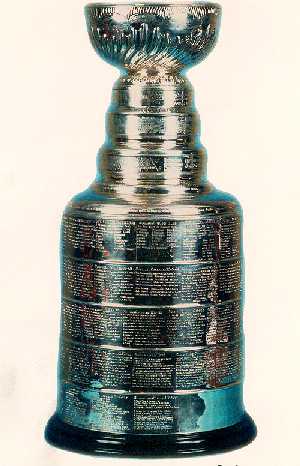 |

The Stanley behind the Stanley Cup was Lord Stanley of Preston, the Governor General of Canada (the Queen's Representative to the Dominion of Canada), the sixth in the long regal line. If you think that's a mouthful, Stanley's full title was the Monty-Python-esque "Right Honourable Sir Frederick Arthur Stanley, Baron Stanley of Preston, in the County of Lancaster, in the Peerage of Great Britain, Knight Grand Cross of the Most Honourable Order of the Bath." (inhale)
Stan The Man became interested in hockey during his stint as Governor General from 1888 to 1893. He offered to pay 10 guineas for a trophy to be used as a challenge cup rewarding the best amateur hockey teams in Canada and first awarded for the 1893-94 hockey season. (Depending on the source you look at, that 10 guineas amounts to either $48.33 or $48.67. Canadian cash, remember.)
An Aide to Stanley bought the Cup itself, which (depending on the source) was made by a silversmith or silversmiths (we don't know who they were) from London or Sheffield. The Cup was more like a bowl--a gold-lined silver bowl on an ebony base, measuring seven inches high and 11-1/2-inches in diameter. (One source lists the original height at 7 1/2 inches.) For about 40 years, Lord Stanley's silver bowl was the entire trophy, but players on championship teams began scratching their initials on the bowl. In response, sometime in the 1940s silver bands were added to the bottom of the bowl with all the names on winning teams engraved on them. The trophy grew to its present height of 35-1/4 inches (or 35-1/2 inches, depending on the source or the ruler) with a base 54 inches in circumferences. It weighs 32 pounds, though, in the words of an ESPN sportscaster, "when you win it, it is but a feather."
Though Stanley wanted his Cup to be the domain of amateur hockey players, professional leagues would eventually elbow their way in. (Amateur teams competed for the Cup until 1910, when the professional National Hockey Association (NHA) was formed, which in 1917 became the National Hockey League (NHL), whose teams competed for the Cup against teams from other [mostly western] pro leagues until 1926. By that time, the other leagues had folded, thus making the Stanley Cup the exclusive domain of the NHL.) In fact, Lord Stanley, later Earl of Derby, returned to England ten months before the first Stanley Cup playoff. Ironically, he never saw a Stanley Cup game.
Lord Stanley effectively abandoned his Cup. He wouldn't be the last person to do so. |